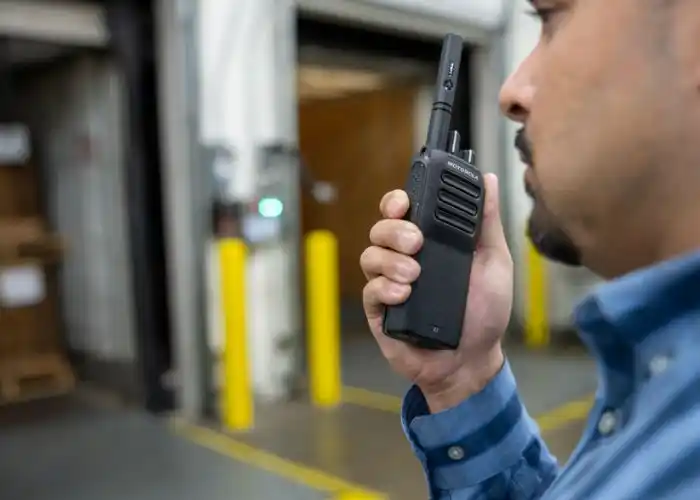Communication is one of those things that we know we need, and we know we can do better, but often don’t think about. But when it comes to business, and certain businesses in particular, communication is at the forefront of everything they do.
In critical situations, like emergencies or large-scale operations, having a reliable communication system can make all the difference. That’s why it’s essential to understand the differences between P25 and DMR, two popular digital radio standards. In this article, we’ll tell you what you need to know.
P25 vs. DMR Communications
P25 and DMR are two digital radio standards designed to improve communication efficiency and reliability. P25, or Project 25, was created specifically for public safety organizations such as police, fire departments, and emergency medical services. Developed by the Association of Public-Safety Communications Officials (APCO) in the 1980s, P25 was intended to replace analog radio systems and provide a more robust, secure, and interoperable communication solution for mission-critical situations.
P25 radios are known for their ability to work seamlessly across different agencies and jurisdictions, which is so important during large-scale emergencies. They offer advanced encryption options to improve secure communications, making them ideal for exchanging sensitive information.
On the other hand, DMR, or Digital Mobile Radio, was developed by the European Telecommunications Standards Institute (ETSI) and is commonly used in commercial and industrial sectors. Introduced in the early 2000s, DMR aims to provide a cost-effective and efficient alternative to analog radios for businesses.
DMR systems are designed to maximize spectrum efficiency and offer clear voice communications, even in noisy environments. They are widely used in manufacturing, transportation, utilities, and hospitality industries. DMR radios are valued for their scalability, allowing organizations to expand their communication networks as needed without significant additional costs.
While both P25 and DMR improve communication capabilities over traditional analog systems, their primary applications differ significantly. P25 is tailored for public safety and mission-critical operations, where secure and reliable communication is so important. In contrast, DMR caters to commercial needs, focusing on cost-effectiveness and efficiency.
Key Differences Between P25 and DMR
Now that you understand the purpose of these two communications systems, let’s get into some of the technical specifications, such as frequency bands, channel bandwidth, and modulation techniques. We’ll also take a brief look at compatibility with other systems and ease of integration. After all, we know that adopting new systems is heavily reliant on interoperability.
Technical Specifications
Let’s get into the technicalities.
1. Frequency Bands
P25 and DMR operate in various frequency bands. P25 systems are available in the VHF (Very High Frequency), UHF (Ultra High Frequency), 700 MHz and 800 MHz bands, which are common in public safety communications.
In Florida, for example, almost all P25 systems were originally built in the 800 MHz band. Those buildouts, coupled with cellular technologies using adjacent frequencies, caused the 800 MHz band to become somewhat crowded. Seeing that trend, the FCC allocated sections of the 700 MHz frequency band and dedicated it to public safety for future P25 system build outs and expansions. Fortunately, 800 MHz Motorola APX radios are also compatible with 700 MHz natively, allowing public safety entities to use their existing devices and not have to buy new radios in a different frequency band.
DMR, however, operates primarily in VHF and UHF, with the occasional system in the 800 MHz or 900 MHz band. This flexibility makes DMR suitable for a wide variety of commercial applications, from small business assignments to large industrial complexes. MOTOTRBO radios are the device of choice for many DMR users.
2. Modulation Techniques
Modulation techniques differ between P25 and DMR.
P25 Phase 1 (FDMA) uses C4FM (Compatible 4-Level Frequency Modulation) for single site operation and CQPSK (Compatible Differential Offset Quadrature Phase Shift Keying) for multiple site operation. P25 Phase 2 (TDMA) uses H-DQPSK (Harmonized Differential Quadrature Phase Shift Keying).
All three are designed to provide clear voice quality and reliable data transmission in public safety environments. This technique ensures that communication remains clear even in challenging conditions.
DMR employs 4FSK (4-Level Frequency Shift Keying) modulation. This efficient technique allows DMR to deliver high-quality voice and data communications while maximizing spectrum efficiency. Using 4FSK modulation helps DMR systems maintain excellent performance in noisy industrial settings.

3. Channel Bandwidth
Channel bandwidth is another critical difference. P25 systems typically use a 12.5 kHz or 6.25 kHz channel bandwidth, which allows for narrowband operation. This narrowband capability is important for public safety agencies operating in crowded radio frequency environments.
DMR systems, however, utilize a 12.5 kHz channel bandwidth but employ a two-slot TDMA (Time Division Multiple Access) technology within this bandwidth. This means that DMR can support two simultaneous voice or data channels in the same 12.5 kHz bandwidth, effectively doubling the system’s capacity without requiring additional spectrum.
Interoperability
Understanding the technical specifications is super important, but equally important is how these systems interact with other communication networks. Interoperability, or the ability to work flawlessly with different systems, plays a big role in the effectiveness of P25 and DMR. Let’s explore their compatibility and ease of integration.
- Compatibility with Other Systems
Interoperability is a major consideration when choosing a communication system. P25 is designed with interoperability in mind, providing highly reliable communication between different public safety agencies and jurisdictions. This is achieved through standardized protocols and interfaces that ensure compatibility with P25 equipment, regardless of the manufacturer.
DMR also supports interoperability but focuses more on ensuring compatibility within commercial and industrial sectors. DMR systems can integrate with other communication systems and devices, making it easier for organizations to adopt and expand their communication networks.
- Ease of Integration
Ease of integration is another important factor. P25 systems are typically more complex and require significant planning and investment to integrate with existing public safety infrastructure. However, they provide a highly reliable and secure communication solution once integrated.
DMR systems, by contrast, are generally easier to implement and integrate with existing communication networks. The modular nature of DMR technology allows you to scale your communication systems according to their needs.
Advantages of P25 for Public Safety
One of the most significant advantages of P25 is its security features. P25 radios provide advanced encryption options, ensuring that sensitive communications remain confidential and secure from unauthorized access. This is particularly important for police and emergency services that handle critical information.
Another advantage of P25 is its superior coverage and reliability. P25 systems are designed to maintain clear communication even in challenging environments. They offer robust signal penetration, which is integral in urban areas with many obstacles. Additionally, some P25 radios, like the Motorola APX NEXT XN, are built to withstand harsh environments and rough conditions, including dust, water, and extreme temperatures.
Remember how we talked earlier about interoperability? Inter-agency communication capabilities are another strength of P25. These radios facilitate flawless communication between public safety agencies, allowing coordinated emergency responses. This interoperability ensures that various agencies can work together efficiently.

Advantages of DMR for Commercial Use
DMR systems are highly valued in commercial settings for their cost-effectiveness. DMR offers a more affordable solution without sacrificing performance compared to other communication systems. This makes it an attractive option for businesses looking to improve their communication capabilities while managing expenses.
Another key advantage of DMR is its ease of implementation. These systems are generally straightforward to set up and integrate with existing infrastructure. This means you can quickly adopt DMR technology without significant downtime or complex installations.
DMR also offers significant benefits in flexibility and scalability. Organizations can start with a basic setup and expand their system as their needs grow. This scalability allows companies to add more users and features over time, accommodating their changing requirements. DMR systems can adapt to various operational demands for small businesses or large enterprises.
Choosing the Right Two-Way Communication System
When deciding between P25 and DMR, you need to assess your organization’s specific communication needs. Consider the type of operations, budget constraints, and future scalability. With its advanced security and reliability, P25 is ideal for mission-critical public safety situations, while DMR offers a cost-effective, flexible solution for commercial use.
At EMCI Wireless, we specialize in two-way radios and are a proud Motorola channel partner. Our expertise can guide you in selecting and implementing the best Motorola two-way radio solutions for your needs. Whether you require the robust features of P25 or the scalability of DMR, EMCI Wireless is your trusted partner in growing your communication infrastructure.
Reach out to us for a free consultation to discuss your options and prioritize seamless communication for your business needs.






